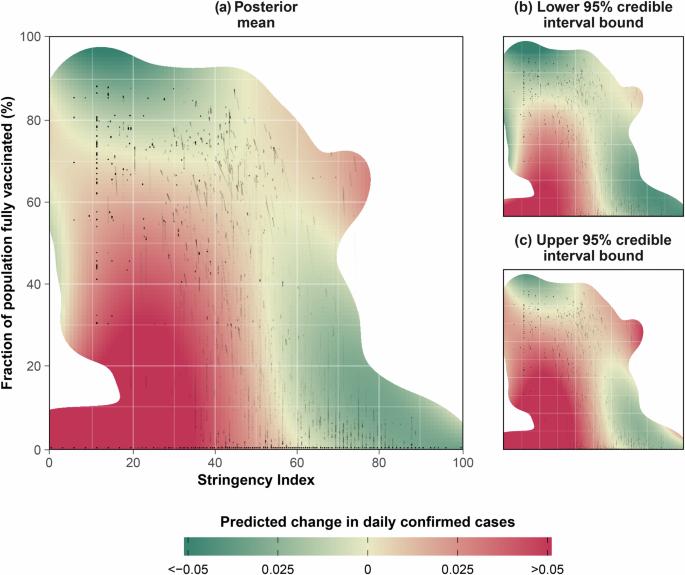Evaluating the direct effect of vaccination and non-pharmaceutical interventions during the COVID-19 pandemic in Europe
IF 5.4
Q1 MEDICINE, RESEARCH & EXPERIMENTAL
引用次数: 0
Abstract
Across Europe, countries have responded to the COVID-19 pandemic with a combination of non-pharmaceutical interventions and vaccination. Evaluating the effectiveness of such interventions is of particular relevance to policy-makers. We leverage almost three years of available data across 38 European countries to evaluate the effectiveness of governmental responses in controlling the pandemic. We developed a Bayesian hierarchical model that flexibly relates daily COVID-19 incidence to past levels of vaccination and non-pharmaceutical interventions as summarised in the Stringency Index. Specifically, we use a distributed lag approach to temporally weight past intervention values, a tensor-product smooth to capture non-linearities and interactions between both types of interventions, and a hierarchical approach to parsimoniously address heterogeneity across countries. We identify a pronounced negative association between daily incidence and the strength of non-pharmaceutical interventions, along with substantial heterogeneity in effectiveness among European countries. Similarly, we observe a strong but more consistent negative association with vaccination levels. Our results show that non-linear interactions shape the effectiveness of interventions, with non-pharmaceutical interventions becoming less effective under high vaccination levels. Finally, our results indicate that the effects of interventions on daily incidence are most pronounced at a lag of 14 days after being in place. Our Bayesian hierarchical modelling approach reveals clear negative and lagged effects of non-pharmaceutical interventions and vaccination on confirmed COVID-19 cases across European countries. As soon as COVID-19 hit Europe in early 2020, non-pharmaceutical interventions such as movement restrictions and social distancing were employed to contain the pandemic. Towards the end of 2020, vaccination was available and promoted as an additional defence. We analysed almost three years of public COVID-19 data to determine how effective both types of strategies were in containing the pandemic across 38 European countries. We developed a statistical model to relate confirmed cases to how strict non-pharmaceutical interventions were and to vaccination levels. Both non-pharmaceutical interventions and vaccination resulted in decreased confirmed cases, although variation exists among countries. When an intervention is applied, the effect on number of confirmed cases could be seen most about fourteen days after implementation. Fajgenblat et. al utilize almost three years of COVID-19 data to model consequences of interventions across Europe. They find that both non-pharmaceutical interventions and vaccination impact daily case rates, with the strongest effect at a lag of 14 days post-implementation.

评估欧洲 COVID-19 大流行期间疫苗接种和非药物干预措施的直接效果
欧洲各国在应对 COVID-19 大流行时采取了非药物干预和疫苗接种相结合的措施。评估这些干预措施的有效性对政策制定者尤为重要。我们利用 38 个欧洲国家近三年的可用数据来评估政府应对措施在控制大流行方面的有效性。我们建立了一个贝叶斯分层模型,将 COVID-19 的每日发病率与过去的疫苗接种水平和非药物干预措施灵活地联系在一起,正如严格指数所总结的那样。具体来说,我们使用分布式滞后法对过去的干预值进行时间加权,使用张量-乘积平滑法捕捉两类干预之间的非线性和交互作用,并使用分层法简化处理各国之间的异质性。我们发现,日发病率与非药物干预措施的力度之间存在明显的负相关,而且欧洲国家之间的干预效果存在很大的异质性。同样,我们观察到疫苗接种水平与日发病率之间存在强烈但更为一致的负相关。我们的结果表明,非线性相互作用决定了干预措施的有效性,在疫苗接种率高的情况下,非药物干预措施的有效性会降低。最后,我们的结果表明,干预措施在实施 14 天后对每日发病率的影响最为明显。我们的贝叶斯分层建模方法揭示了非药物干预措施和疫苗接种对欧洲各国 COVID-19 确诊病例的明显负面滞后效应。2020 年初,COVID-19 在欧洲肆虐时,人们立即采取了行动限制和社会疏远等非药物干预措施来控制疫情。在 2020 年底,疫苗接种作为一种额外的防御手段得到了推广。我们分析了近三年的 COVID-19 公共数据,以确定这两种策略在控制欧洲 38 个国家大流行方面的有效性。我们建立了一个统计模型,将确诊病例与非药物干预措施的严格程度和疫苗接种水平联系起来。非药物干预措施和疫苗接种都减少了确诊病例,但各国之间存在差异。在采取干预措施后,对确诊病例数量的影响最多可在实施后 14 天显现。Fajgenblat 等人利用 COVID-19 近三年的数据,建立了欧洲干预后果模型。他们发现,非药物干预措施和疫苗接种都会对每日病例率产生影响,实施后 14 天的滞后效应最大。
本文章由计算机程序翻译,如有差异,请以英文原文为准。
求助全文
约1分钟内获得全文
求助全文

 求助内容:
求助内容: 应助结果提醒方式:
应助结果提醒方式:


